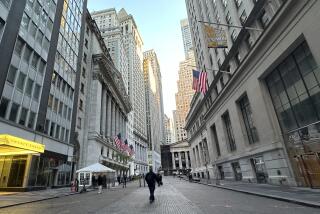Leading Indicators Index Rises for 5th Month, but Signs Point to Slowing
- Share via
A key gauge of national economic activity strengthened for a fifth consecutive month in June, adding to signs of steady, if slower, expansion ahead, the Conference Board said Monday.
The index of leading indicators, which is supposed to forecast economic trends six to nine months ahead, rose by 0.5 percentage point in June after a revised 0.2 percentage point increase in May.
Despite the overall rise in the index, individual components showed waning factory orders and backlogs that may foreshadow a slower economic pace in the final six months of the year.
“What it points to is a continuing moderate economic growth, not another boom or surge in economic activity,” said economist Sung Won Sohn of Norwest Corp. in Minneapolis.
Economists said the latest indicators were not enough to sway them from the recently drawn general conclusion that the Federal Reserve Board will leave interest rates unchanged at its Aug. 20 policy-setting meeting.
Signs of a surging economy could revive inflation fears and lead the nation’s central bank to raise rates.
“This will not affect the Fed’s deliberation. I don’t think the Fed is going to move,” said Stephen S. Roach, chief economist at Morgan Stanley & Co. “A lot of us, including myself, changed our view of the Fed. For me, it was the Friday numbers.”
On Friday, the Labor Department said about 193,000 jobs were created in July, down from an average of 273,000 a month during the second quarter and slightly below Wall Street forecasts. Also, the Commerce Department reported that consumer spending fell 0.2% in June and that factory orders dropped 0.9% that month.
Analysts emphasized that the economy is at no risk of a precipitous slowdown but is unlikely to keep growing at the booming 4.2% annual rate of increase in gross domestic product posted in the second quarter this year.
“The fact that the index is positive for a fifth month indicates economic growth is on track,” Norwest’s Sohn said. “I don’t think we need to worry that the economy will fall off its chair and into a recession soon.”
The June reading of 102.9 is the highest ever for the index under its current formula, which is changed periodically, said Michael Boldin, a senior economist at the New York-based Conference Board. The index, until recently compiled by the government, was first calculated in the late 1960s.
Its previous high, figuring backward historically using its current construction, was 102.6, first hit in December 1994, Boldin said. It achieved that level again in January 1995.
The index measures a basket of economic indicators, from unemployment benefit claims to building permits. Six of its 11 components were higher in June, whereas five weakened from May.
The signals of rising activity in June were led by increased commodity prices, slower vendor deliveries that implied a faster pace of business, rising consumer expectations and a bigger money supply.
The average workweek was also longer than in May, and stock prices were higher.
(BEGIN TEXT OF INFOBOX / INFOGRAPHIC)
Leading Indicators
Seasonally adjusted index; 1987=100
June 1996: 102.9
Source: Conference Board
More to Read
Inside the business of entertainment
The Wide Shot brings you news, analysis and insights on everything from streaming wars to production — and what it all means for the future.
You may occasionally receive promotional content from the Los Angeles Times.










